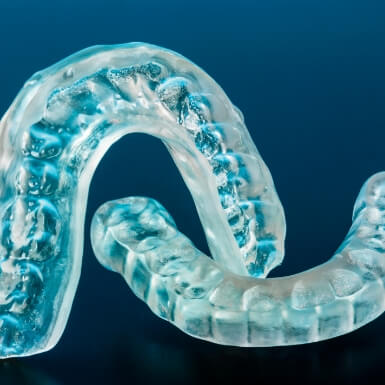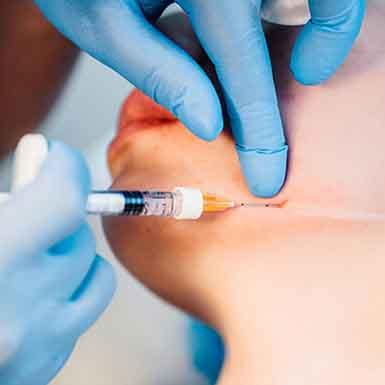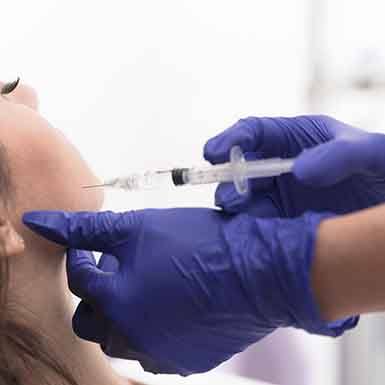Treating TMJ Disorder– Aspen Hill, MD
The Right Solutions for Each Patient
At Exceptional Dentistry Pain & Sleep Solutions, our mission is simple—we help our patients finally discover what is causing their pain, and then we make it go away. To do that, Dr. Saba relies on a variety of proven treatments, all of which have a track record of addressing TMD-related pain. With one or more of the procedures listed below for treating TMJ disorder in Aspen Hill, MD, she will use her expertise to pave your way toward a pain-free future.
Why Choose Exceptional Dentistry Pain & Sleep Solutions for Treating TMJ Disorder?
- Short & Long-Term Relief Options
- Medication & Surgery-Free Solutions
- Specially Trained to Provide Botox
Treatment with TENS Machine
“TENS” stands for “transcutaneous electrical nerve stimulation,” and while that might be a mouthful, the way it works is fairly simple. Small electrode patches are placed on the face and jaw, and these send gentle electric currents into the muscles. This can reduce pain, help with inflammation, and stimulate blood flow to the area, all of which can help provide immediate relief for TMD sufferers.
Occlusal Splint

An occlusal splint is a small oral appliance that a patient only has to wear to bed. It can protect the teeth from unconsciously grinding together during sleep, and it can also slightly reposition the jaw into a more relaxed and natural position. This can allow the muscles to finally heal, plus this can create a more open airway, which can help reduce (often interrelated) sleep issues.
Equilibrations/ Occlusal Adjustment

When the teeth don’t quite come together properly when the mouth is closed, the jaw muscles will unconsciously try to force them into the “right” position. This can quickly tire the muscles, leading to soreness and pain. Plus, an imbalance in the bite can create high-pressure spots that cause toothaches as well. With an equilibration, small adjustments are made to the teeth (either by removing a few millimeters of enamel or placing restorations) so that when the mouth is closed, the teeth, bite, and jaw all line up. This allows the muscles to relax, which will prevent the pain before it starts.
BOTOX for TMJ Treatment

Yes, Botox is a great way to help reduce pain and discomfort associated with TMD! Instead of using it to stop the muscle contractions that create facial wrinkles, Dr. Saba can instead inject it into overactive jaw muscles. This cannot only provide immediate relief from TMD, but it can also stop chronic teeth grinding and even help shrink the masseter muscles (the muscles on either side of the jaw that help you chew) to create a more defined jawline. Continue reading to learn more about BOTOX and how it can help to give you some relief.
What Is BOTOX?

BOTOX is a diluted form of the bacteria botulinum toxin. This formulation is designed to help relax or loosen the muscles. While BOTOX is often used with cosmetic goals in mind, it can also be helpful for treating the symptoms of a variety of conditions, including TMD. In many cases, BOTOX injections for TMJ can be completed within 20 to 30 minutes, and each injection just takes a moment to perform. You can usually feel the results after 5 to 10 days, and they last for three to four months based on how your body reacts to the medicine.
Who Is a Good Candidate for BOTOX?

BOTOX has been shown to be helpful for those who are struggling with muscle spasms, jaw tension, and pain in the face due to strained joints and muscles. This quick procedure can provide temporary relief so you can get a break from the discomfort your TMD is causing you. BOTOX for TMJ is generally recommended for those who experience the following symptoms:
- Jaw discomfort and tenderness
- Limited mobility of the jaw
- Difficulty chewing food
- Earaches or ringing in the ears
How Can BOTOX Treat TMJ Disorder?

BOTOX use for TMJ disorders helps to effectively reduce pain in your oral movements for several months. A recent study found that this method can improve approximately 90% of patient’s symptoms. Injections in the muscles around the jaw joints can help to alleviate symptoms, such as headaches, severe bruxism, and much more.
